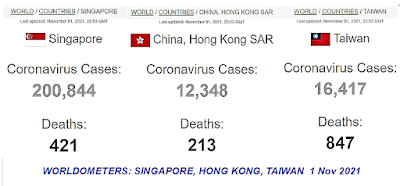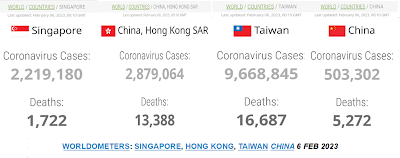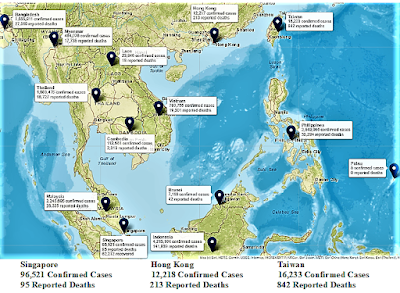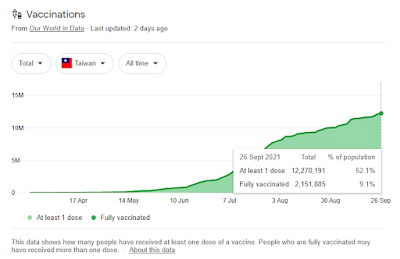Update: 7 Oct 2023 Worldometer COVID-19 Coronavirus Pandemic
WORLDOMETERS: SINGAPORE, HONG KONG, TAIWAN & CHINA 7 OCT 2023
WORLDOMETERS: SINGAPORE, HONG KONG, TAIWAN & CHINA 13 FEB 2023
WORLDOMETERS: SINGAPORE, HONG KONG, TAIWAN & CHINA 6 FEB 2023














WORLDOMETERS: SINGAPORE, HONG KONG, TAIWAN & CHINA 6 JAN 2023


















WEF 13 Feb 2023: COVID-19 treated as Endemic, DORSCON Yellow to Green, Mask-wearing not required on Public Transport, as Singapore eases remaining Covid-19 rules
Updated 7 Oct 2023: COVID-19: Tracking new variants
New variants of SARS-CoV-2, the virus that causes COVID-19, will continue to occur. CDC coordinates collaborative partnerships which continue to fuel the largest viral genomic sequencing effort to date. The Omicron variant, which emerged in November 2021, has many lineages. New lineages continue to emerge and spread in the United States and globally.
Viruses constantly change through mutation and sometimes these mutations result in a new variant of the virus. Some changes and mutations allow the virus to spread more easily or make it resistant to treatments or vaccines. As the virus spreads, it may change and become harder to stop.
Understanding the Variants:
- How Variants Work - If you think about a virus like a tree growing and branching out, each branch on the tree is slightly different than the others. By comparing the branches, scientists can label them according to the differences. These small differences, or variants, have been studied and identified since the beginning of the pandemic. Some variations allow the virus to spread more easily or make it resistant to treatments or vaccines. Those variants must be monitored more carefully.
- How the Virus May Change - As a virus spreads, it has a chance to change. As genetic changes happen over time, the virus that causes COVID-19 begins to form genetic lineages. The SARS-CoV-2 virus can be mapped out similar to a family tree. All lineages have names to help scientists talk about them. SARS-CoV-2 lineages with similar characteristics may affect how fast the virus spreads, the severity of illness it causes, or the effectiveness of treatments against it; some of these may be classified by the World Health Organization (WHO) or the U.S. SARS-CoV-2 Interagency Group (SIG). All lineages currently circulating are classified as part of the Omicron variant.
Singapore experiencing new COVID-19 wave, more people expected to fall sick in coming weeks
Singapore is experiencing another COVID-19 infection wave, with more people expected to fall sick and be hospitalised in the coming weeks, Health Minister Ong Ye Kung said on Friday (Oct 6). However, he added that there are no plans to impose any social restrictions, as with the last wave which occurred from March to April.
Speaking at the official opening of the Stepping Stones Rehabilitation Centre and Serenity Centre at the Institute of Mental Health, Mr Ong revealed that the estimated daily cases has risen from about 1,000 three weeks ago to 2,000 for the past two weeks. The spate of cases is driven by mostly two variants - the EG.5 and its sub-lineage HK.3 - both of which are descendants of the XBB Omicron variant. "Together, they now account for over 75 per cent of our daily cases," Mr Ong said.
During the peak in April, the number of infections rose to about 4,000 cases a day. "We will treat this as an endemic disease, which is in line with our strategy, and we will live with it," he said. "After all, there has been no evidence to suggest that the new variants are more likely to lead to severe illnesses compared to previous variants.
related:
Number of Covid-19 infections in Singapore more than doubled in Sept 17-23 week
Singapore no longer requires reporting of Covid-19 cases, so these numbers generally reflect those who sought medical care. The Ministry of Health (MOH) said it is monitoring the situation, but does not think there is a need to worry as the number of people infected “is currently low compared to previous waves”. “The average daily new Covid-19 hospitalisations and average daily new ICU (intensive care unit) cases have also remained low,” it said about the current spike in cases on its Covid-19 website.
The peak number of infections this year was 28,410 a week at the end of March. That week, 159 people were hospitalised, a slight increase over the 139 in the previous week; and seven needed to be admitted to intensive care, up from six in the previous week. However, hospitalisation and the need for intensive care usually lag infections. The infection peak at the end of March had led to a higher number of hospitalisations and admissions to the ICU in April.
Covid-19 is no longer global health emergency - WHO
Covid-19 is here to stay even if it no longer represents an emergency, the agency said. PHOTO: REUTERS
The WHO’s emergency committee met on Thursday and recommended the UN agency declare an end to the public health emergency of international concern, which has been in place for more than three years. “It’s therefore with great hope that I declare Covid-19 over as a global health emergency,” said WHO director-general Tedros Adhanom Ghebreyesus, adding that the end of the emergency did not mean Covid-19 was over as a global health threat.
The WHO’s emergency committee first declared that Covid-19 represented its highest level of alert on Jan 30, 2020. The status helps focus international attention on a health threat, as well as bolstering collaboration on vaccines and treatments. Lifting it is a sign of the progress the world has made in these areas, but Covid-19 is here to stay, the WHO said. “Covid has changed the world, and it has changed us. And that’s the way it should be. If we go back to how things were before Covid-19, we will have failed to learn our lessons, and failed our future generations,” said Dr Tedros.
World Health Organisation WHO
In Singapore, from 3 January 2020 to 4:16pm CEST, 3 May 2023, there have been 2,368,597 confirmed cases of COVID-19 with 1,722 deaths, reported to WHO. As of 27 March 2023, a total of 14,904,028 vaccine doses have been administered.
SINGAPORE EXIT ACUTE PHASE OF PANDEMIC
In line with the transition to DORSCON Green, key COVID-19 Statistics will be consolidated on the COVID-19 Statistics page and updated on a weekly basis from 13 February 2023, to align with reporting for other endemic infectious diseases in the Weekly Infectious Diseases Bulletin. Singapore’s COVID-19 situation has remained stable in recent months. This is despite increased travel over the year-end holiday period, the Northern Hemisphere winter season and China’s shift away from a Zero-COVID policy. We are therefore able to step down the remaining few COVID-19 measures, and establish an endemic COVID-19 new norm. That said, the virus will continue to evolve, and we should expect new infection waves from time to time, and over and over.
An endemic COVID-19 new normal will therefore not be static, and we will adjust our measures when necessary. But unless it is a very dangerous and virulent variant, we should be able to manage these subsequent waves with an appropriate level of measures that does not deviate significantly from the new norm, and continue to live our lives normally. Globally, the number of new COVID-19 cases has been declining since late December 2022, and viral variants of higher severity have not emerged. Infection waves in the Northern Hemisphere and in China are rapidly subsiding. Locally, there was no significant increase in the number of imported cases. The World Health Organization has recently acknowledged that the pandemic is nearing a turning point, signaling that the global COVID-19 emergency may be ending soon. Amidst the improving international situation, several countries have recently eased COVID-19 measures or signaled further steps towards treating COVID-19 as an endemic disease.
Our population has developed a high level of hybrid immunity and is well protected from severe COVID-19. Around 80% of our population have achieved minimum protection, and around half are up to date with their vaccinations. Many have also recovered from infection during previous COVID-19 waves. With this, the risk of COVID-19 infections leading to severe illness or death has become very low, comparable to other endemic respiratory diseases, such as influenza or pneumococcal infections. Over January 2023, the daily number of COVID-19 related hospitalisations stayed below 100, and daily COVID-19 related patients in the Intensive Care Unit (ICU) remained in the single digits. The Disease Outbreak Response System Condition (DORSCON) framework gives an indication of the current disease situation. With the stable global and local situation, the mild nature of the disease especially among vaccinated individuals, and the minimal disruption posed to our healthcare capacity and daily lives, we will adjust the current DORSCON level from Yellow to Green from 13 February 2023. From 13 February 2023, we will step down the following community measures:
- Mask-wearing
- Revised Health Advisory
- Public Health Measures for Migrant Workers Living in Dormitories
- Stepping Down TraceTogether (TT) and SafeEntry (SE)
- Regularising COVID-19 Financing Schemes
- Stepping Down Border Measures
- Vaccination as our Primary Defence in Living With COVID-19
- Vaccination Requirements for Permanent Residence, Long Term Passes and Work Passes Remain in Place
- Standing Down of the Multi-Ministry Taskforce
- Staying Vigilant
- Reflecting on Our Fight Against COVID-19
Through the frontliners' eyes, what went well and what fell short in Singapore's COVID-19 fight
Infectious disease expert Leo Yee Sin said Singapore has reached a significant milestone of ‘normalcy’ in its fight against COVID-19 with remarkable achievement, and it is now time to reflect on areas of deficiency and learn from the lessons to further strengthen Singapore’s capability to take on emerging infections. (Illustration: TODAY/Anam Musta'ein)
After three years battling COVID-19, Singapore this week exited the acute stage of the pandemic. Singapore's efforts at battling the unprecedented pandemic has won international applause. Experts said one area Singapore did well in is its rapid procurement of COVID-19 vaccines and test kits. But there were also missteps in the handling of the pandemic. One of them was the Government’s response to the outbreak in migrant worker dormitories.
Singapore has come full circle since its first COVID-19 case surfaced in January 2020, from a lockdown, shuttered borders, ever-changing permitted group sizes, mass vaccination programme, to a mask-lite existence in recent days. Along the way, its efforts at battling the unprecedented pandemic has also won international plaudits.
AREAS WHERE SINGAPORE DID WELL:
- Procurement of vaccines and test kits
- Science-based approach
- Whole-of-Government response and communication
AREAS WHERE SINGAPORE FELL SHORT:
- Handling of outbreak in migrant worker dormitories
- Well-being of healthcare workers
Will Dorscon Green Spell The End of Lee Hsien Loong’s Term as Prime Minister?
“I had expressed the hope that I would be able to hand over by the time I celebrate my 70th birthday. But I do not determine the path of the Covid-19 pandemic, and it will also depend on how events unfold. And all I can say is, I will see this through. And I’ll hand over in good shape as soon as possible to the next team, and into good hands.”
In July 2020, Prime Minister Lee Hsien Loong said that he hopes to step down when he turns 70. That came last year – he will turn 71 in 2023. However, Singapore was not out of the woods with regards to the Covid-19 pandemic. The Covid-19 alert was sounded in Singapore in Feb 2020, when Dorscon Orange was announced. Yesterday, it was downgraded to green to inform the Singaporean public that all restrictions have been lifted and life goes back to normal.
Finance Minister and Deputy Prime Minister Lawrence Wong has already been touted as the PM-in-waiting. So with Covid out of the way and a potential new heir to the throne, are PM Lee’s days as prime minister numbered?
No masks on public transport, free vaccines: 6 things you need to know as S’pore lifts Covid-19 rules
This was among the changes to measures that the multi-ministry task force tackling Covid-19 announced on Thursday.
This comes more than three years after the first Covid-19 case was reported in Singapore on Jan 23, 2020. Here’s what you need to know about the changes:
- No masks required on public transport
- Covid-19 vaccines remain free
- Treatment and testing no longer fully subsidised from April 1
- TraceTogether and SafeEntry no longer required
- Unvaccinated travellers entering S’pore do not need pre-departure test
- Migrant workers no longer need to apply for pass to enter popular places
Where is Singapore headed in its new post-COVID-19 norm?
Three years and two days ago, Singapore raised its alert level for the COVID-19 outbreak to code orange. Hours later, long queues started appearing at supermarkets across the island, with residents stocking up on necessities in case of a lockdown.
That lockdown, or circuit breaker, came two months later on Apr 3, 2020. Most workplaces were closed and schools went into home-based learning mode. Residents were advised to remain home and avoid socialising with others. Masks became mandatory soon after. On Thursday (Feb 9), the COVID-19 multi-ministry task force held its last press conference, announcing an end to three years of restrictions that aimed first to contain the COVID-19 outbreak and then to mitigate its impact.
Singapore will move to DORSCON green on Monday, the lowest alert level since the pandemic started. During the last three years, our lives were restricted and more than 1,700 people died from COVID-19, but both the social and health impacts were much worse in most comparable countries. What, then, are the lessons for future health crises? The first striking point is how ready Singaporeans were to take the steps that medical experts and the Government recommended to prevent spread. Mask-wearing in Singapore was not as common before COVID-19 as it was in Japan.
What does endemic mean when it comes to COVID?
First the coronavirus was an epidemic, then it became a pandemic, and now we're starting to hear over and over again that it's on its way to becoming endemic. That means COVID will forever be part of our lives in some form, like how the Spanish flu of 1918 morphed over time into the common flus of today.
As we grapple with Delta rage, it's helpful to understand what endemic means when it comes to COVID both in terms of what we do in the present and what our day-to-day will look like in the future. For starters, even if COVID will eventually become endemic, it doesn't mean we should give up trying to contain the virus, public health experts have said. And if more of us get vaccinated now, and maybe one day annually, getting COVID may mean a few days of discomfort and then bouncing back to normal until we do it all again the following year. "There will be a time in the future when life is like it was two years ago: You run up to someone, give them a hug, get an infection, go through half a box of tissues, and move on with your life," Emory University researcher Jennie Lavine told The Atlantic. "That’s where we’re headed, but we’re not there yet."
What does endemic mean? When a disease spikes suddenly in a certain area, that's an epidemic. When that disease spreads uncontrollably into multiple countries, that's a pandemic. When it burrows so deep that it constantly hums along, albeit at controlled, predictable levels, that means it's endemic.
We may be entering Covid’s least predictable year yet
The Covid-19 outbreak is officially three years old on 30 Jan 2023, which marks the moment in 2020 when the World Health Organization declared the respiratory disease a public health emergency of international concern. But this month’s anniversary offers little to celebrate in the wake of China’s chaotic and abrupt lurch from zero-Covid to full-Covid.
Beijing has dramatically reduced testing, junked contact tracing and is scrapping most quarantine requirements; some regions now permit infected people with mild or no symptoms to go to work. The pandemic virus is thus free to circulate unobserved in a sixth of the world’s population — just as the rest of the globe is clamouring for normality. As the third year of the outbreak closes amid reports of overflowing hospitals in China and fresh restrictions on air travellers, and with the Chinese new year holiday fast approaching, the pandemic seems somehow more familiar and less predictable than ever.
China is right to abandon its inhumane and unworkable zero-Covid policy, but it has done so from a position of relative weakness. A headline 90 per cent vaccination rate masks the reality that its homegrown vaccines are less effective than the mRNA ones used widely elsewhere, and that around 30 per cent of the country’s 260mn over-60s (and more than half of its over-80s) have not received a third dose. Those factors have led to hair-raising projections, ranging from 1mn deaths this year to 1.7mn deaths by the end of April — and has prompted the EU to offer free vaccines to China.
China reopens borders in final farewell to zero-COVID
Travellers began streaming into mainland China by air, land and sea on Sunday (Jan 8), many eager for long-awaited reunions, as Beijing opened borders that have been all but shut since the start of the COVID-19 pandemic.
After three years, mainland China opened sea and land crossings with Hong Kong and ended a requirement for incoming travellers to quarantine, dismantling a final pillar of a zero-COVID policy that had shielded China's people from the virus but also cut them off from the rest of the world.
China's easing over the past month of one of the world's tightest COVID-19 regimes followed historic protests against a policy that included frequent testing, curbs on movement and mass lockdowns that heavily damaged the second-biggest economy.
Singapore confirms first case of Wuhan virus on 23 Jan 2020
Guests at Shangri-La's Rasa Sentosa Resort & Spa yesterday. A man from China who is the first to test positive for the Wuhan virus in Singapore had stayed at the resort, said the Health Ministry. ST PHOTO: TIMOTHY DAVID
A China national has tested positive for the Wuhan virus in Singapore, with another likely to have the virus.
The 66-year-old man, a Wuhan resident, arrived in Singapore with nine travelling companions on Monday (Jan 20), and stayed at Shangri-La's Rasa Sentosa resort, the Ministry of Health said at a briefing on Thursday night (23 Jan 2020).
All the rooms at the hotel where the man and his travelling companions stayed in have been sanitised and sealed off.
Singapore reports first deaths from COVID-19
Two patients died from Covid-19 on Saturday morning (March 21) due to complications, the first deaths the Republic has seen.
A 75-year-old Singaporean woman with a history of chronic heart disease and hypertension died at 7.52am.
She had been admitted to the National Centre for Infectious Diseases (NCID) on Feb 23 for pneumonia and was confirmed to have Covid-19 the same day.
read more
REUTERS COVID-19 TRACKER: SINGAPORE
Average number of new infections reported in Singapore each day reaches new high: Now reporting more than 2,300 daily.
COVID-19 infections in Singapore are at their peak — the highest daily average reported — now at 2,397 new infections reported each day. There have been 106,318 infections and 121 coronavirus-related deaths reported in the country since the pandemic began.
Singapore has administered at least 9,486,020 doses of COVID vaccines so far. Assuming every person needs 2 doses, that’s enough to have vaccinated about 83.2% of the country’s population.
REUTERS COVID-19 TRACKER: HONG KONG
Hong Kong is reporting 4 new infections on average each day, 3% of the peak — the highest daily average reported on July 30.
There have been 12,238 infections and 213 coronavirus-related deaths reported in the country since the pandemic began.
Hong Kong has administered at least 8,745,399 doses of COVID vaccines so far. Assuming every person needs 2 doses, that’s enough to have vaccinated about 58.2% of the country’s population.
REUTERS COVID-19 TRACKER: TAIWAN
COVID-19 infections are decreasing in Taiwan, with 7 new infections reported on average each day. That’s 2% of the peak — the highest daily average reported on May 30.
There have been 16,262 infections and 844 coronavirus-related deaths reported in the country since the pandemic began.
As COVID-19 infections began to be reported around the world, many countries responded by shutting down places like schools, workplaces and international borders in order to contain the spread of the virus.
REUTERS COVID-19 TRACKER: MAINLAND CHINA
COVID-19 infections are decreasing in Mainland China, with 29 new infections reported on average each day. That’s 1% of the peak — the highest daily average reported on February 13.
There have been 96,284 infections and 4,636 coronavirus-related deaths reported in the country since the pandemic began.
Mainland China has administered at least 2,214,564,000 doses of COVID vaccines so far. Assuming every person needs 2 doses, that’s enough to have vaccinated about 79.2% of the country’s population.
COVID-19: Singapore, Hong Kong, Taiwan & China
Singapore has one of the world's highest vaccination rates at 82%, yet cases of COVID-19 are skyrocketing from just double digits in August to well over 3,000 cases a day now. Infectious disease physician Dale Fisher of the National University Hospital says Singapore is letting nature take its course.
Singapore's health experts say exiting the pandemic will mean a carefully calibrated lifting of lids and laying them back on again as needed. Fisher says it may take another year or two. Meanwhile, he says don't expect a Singapore version of the U.K.'s Freedom Day, where almost all COVID-19 restrictions were lifted.
related:
COVID-19: Singapore enters Phase 2 reopening of 'CB'
Died but not classified as a Covid-19 death
COVID-19: Singapore exits 'Circuit Breakers'
Charged with COVID-19-related offences
COVID-19: Returning to Normalcy
Dormitory Infections Push Singapore Covid-19 Cases to New Record
Singapore activates 'Circuit Breakers' to minimise spread of Covid-19
How Singapore, Hong Kong, Taiwan are responding to Covid-19
When A Mask Is A Must
COVID-19: Singapore enters new phase of community transmission
Singapore reports first deaths from COVID-19
COVID-19: Deers & Monkeys roaming for food
Was Coronavirus Predicted in 1981 or 2008?
Died but not classified as a Covid-19 death
COVID-19: Singapore exits 'Circuit Breakers'
Charged with COVID-19-related offences
COVID-19: Returning to Normalcy
Dormitory Infections Push Singapore Covid-19 Cases to New Record
Singapore activates 'Circuit Breakers' to minimise spread of Covid-19
How Singapore, Hong Kong, Taiwan are responding to Covid-19
When A Mask Is A Must
COVID-19: Singapore enters new phase of community transmission
Singapore reports first deaths from COVID-19
COVID-19: Deers & Monkeys roaming for food
Was Coronavirus Predicted in 1981 or 2008?
COVID-19 panic: Why are people stockpiling toilet paper?
COVID-19 fears prompt panic buying across the World
Singapore urges calm after panic buying hits supermarketsCOVID-19 fears prompt panic buying across the World
Singapore reports its first cases of local COVID-19 transmission
Singapore confirms cases of COVID-19 Virus

























